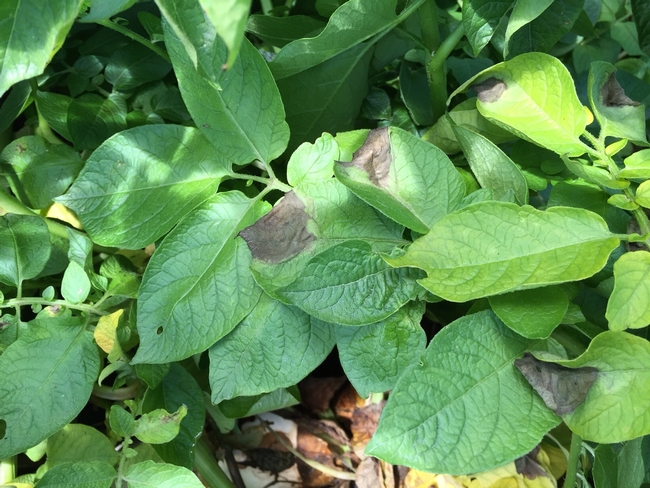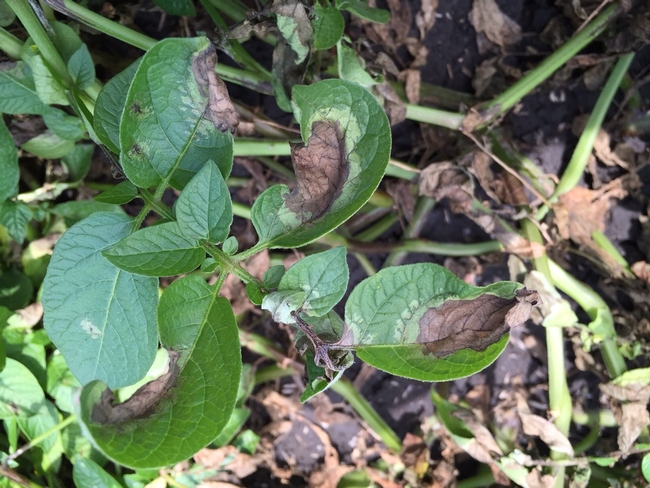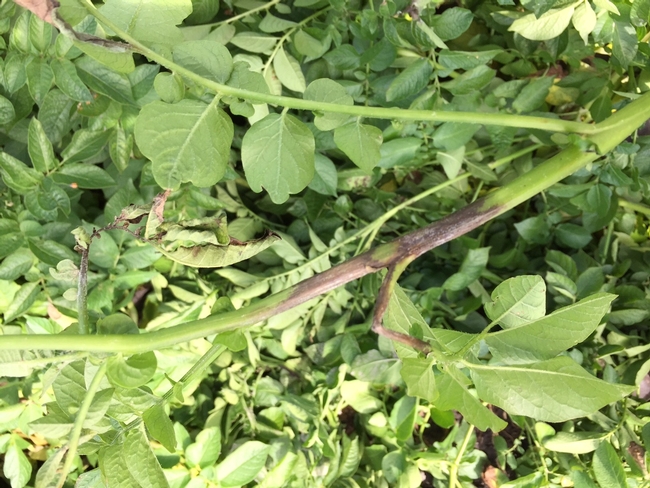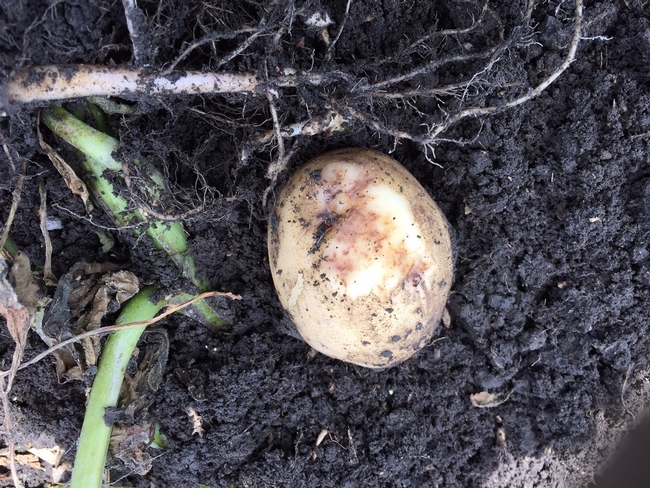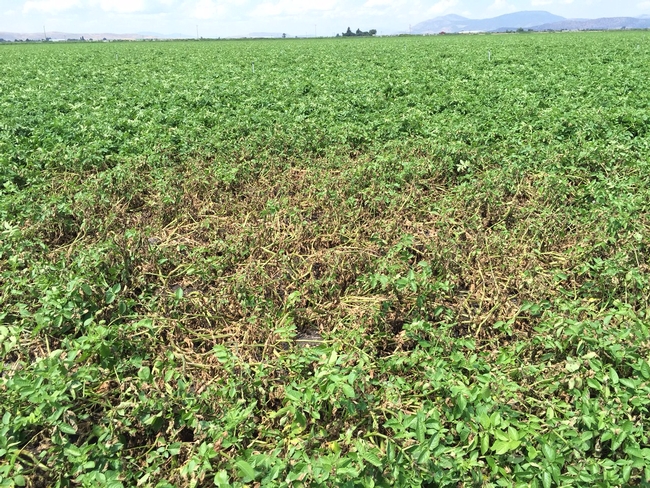Good Afternoon Potato Folks,
Late blight has been positively confirmed via lab test results sent off by Brian Charlton. All submitted samples were determined to be the US-23 strain. US-23 is sensitive to mefenoxam (Ridomil). For more information on late blight strains, see the USAblight website http://usablight.org . This website is an excellent resource on late blight in potatoes and it includes an occurrence map for all reported outbreaks in the United States in 2015.
Late blight has been found in multiple fields in the Tulelake NWR lease lands and in multiple fields outside the lease lands. All Tulelake potato growers need to manage potato fields to prevent late blight infection and spread. The recent smoke and cooler temperatures have slowed crop water use, but environmental conditions in the Klamath Basin still favor late blight development and spread especially in fields with full canopy closure.
Below is a list of management suggestions for late blight. All of the information described below was compiled from University or professional publications. A list of publications I referenced is included below. I encourage everyone to read these reports and visit the USAblight website to learn as much as possible about this devastating disease. The big challenges ahead of us are preventing the spread of late blight during harvest and storage and preventing the reoccurrence of late blight from volunteers and culls next year. Growers and PCAs should keep record of infected fields. You will want to aggressively control volunteer potatoes in these fields next year. Growers need to educate their employees about what late blight looks like and how to prevent spreading the disease. I've included several pictures I took last week of late blight on foliage and tubers for your reference.
Late Blight Management Suggestions
- Scout fields regularly; scouting should continue even after vines start to die from Verticillium wilt and natural causes. Disinfect clothes and equipment after leaving infected fields!
- Leaf wetness is a critical factor in late blight infection. Do not over-irrigate. Try to space out irrigations to prevent periods of extended leaf wetness. If you are still irrigating every 3 to 4 days you are over-irrigating potatoes!
- Continue late blight fungicide applications until vines are dead- Consider pre-harvest intervals when choosing fungicides close to harvest.
- Several fungicides are labeled for late blight in potatoes. Always read the label. Consult and follow lease land PUPs if you use fungicides on lease lands. Fungicides work best when applied before infection occurs or in very early stages of development. Fungicides need to be applied frequently to provide continual protection. University of Idaho publications recommend every 5 to 7 days in infected fields and every 7 to 10 days in neighboring fields. Effective products include Acrobat, Bravo, Curzate, EBDC products including Dithane mancozeb and metiram, Gavel, Omega, Previcur, Ranman, Revus Top, Tanos, Zampro, and Zing. Some systemic products are premixed with a protectant, and some products recommend use in tandem with a protectant such as chlorothalonil (Bravo) or EBDC. Mefenoxam (Ridomil products) is effective and can be used since the US-23 strain has not shown resistance.
- Phosphorous acid products (Phostrol, Resist 57, Phiticide) can help with tuber protection from late blight and they are effective at protecting healthy tubers in storage. These products do not protect foliage. They can be applied in season or post-harvest. At this point of the season, applications should be post-harvest going into storage. Read the University of Idaho publication on this subject for detailed information.
- Be sure vines are completely dead prior to harvest to prevent spreading the disease onto tubers.
- Educate employees what late blight infected tubers look like and have them notify someone immediately if they find them during field and harvest operations
- Avoid harvesting in wet weather and water-logged soils. Moisture increases the risk of spreading pathogen spores and propagules during harvest and storage.
- Minimize wounding tubers during harvest.
- Avoid storing infected lots. If infected lots must be stored, store them separately from healthy lots.
- Remove rotted and diseased tubers before potatoes go into storage and destroy all culls.
Suggestions for Organic Growers
- Management options are limited. You need to take all precautions to prevent spread of late blight into organic fields.
- Leaf wetness promotes infection. Do not over-irrigate! Try to space out irrigations as much as possible and minimize the duration the potato canopy stays wet.
- Copper products have been shown to reduce late blight infection. They must be applied prophylactically (before infection) and with complete coverage of foliar surfaces.
- If late blight occurs in isolated sections of a field, consider destroying infected plants. Killing living potato tissues halts further spore production. Neighboring healthy plants can be infected without symptoms, so it is recommended to kill all plants in a 100 ft buffer around symptomatic plants.
- Consider using an organic-approved vine kill method especially for varieties with late season vigor. Allowing at least two weeks between complete vine-kill and harvest can help minimize harvesting infected tubers. Flaming is likely the quickest organic vine-kill option.
- Harvest during dry weather and avoid water-logged soil conditions. Any moisture increases the risk of spreading pathogen spores and propagules during harvest and storage.
- Minimize wounding and bruising tubers. Sort out rot and infected tubers going into storage and destroy all cull potatoes.
List of Publications
Potato Late Blight UC-IPM Guidelines http://www.ipm.ucdavis.edu/PMG/r607101211.html
Checklist for Managing Late Blight Approaching Harvest and Into Storage- Nora Olsen and Jeff Miller http://www.pnwpestalert.net/uploads/1222_3.pdf
Fungicides for Managing Late Blight in Potato- Jeff Miller, Terry Miller, Trent Taysom, and Phillip Wharton http://www.millerresearch.com/agricultural-research/agricultural-research-reports/potato-research-reports/late-blight/item/44-late-blight-fungicide-management
Efficacy of Phosphite-Based Fungicides for Controlling Pink Rot and Late Blight- Shane Clayson, Jeff Miller, Lyndon Porter, and Nora Olsen http://www.cals.uidaho.edu/potatoes/Research&Extension/Topic/Diseases/EfficacyOfPhosphiteBasedFungicidesForControllingPinkRot&LateBlight-05.pdf
Late Blight in Southern Idaho August 2015- Jeff Miller, Phillip Wharton, Nora Olsen, and Mike Thornton http://www.millerresearch.com/alerts/pest-alerts/item/49-late-blight-management-2015
Organic Alternatives for Late Blight Control in Potatoes- George Kuepper and Preston Sullivan- https://attra.ncat.org/attra-pub/summaries/summary.php?pub=123
Organic Management of Late Blight of Potato and Tomato- Alex Stone http://www.extension.org/pages/18361/organic-management-of-late-blight-of-potato-and-tomato-phytophthora-infestans#.Vcy0-02FOM8
USAblight Management Information- http://usablight.org/managing
Attached Images:
